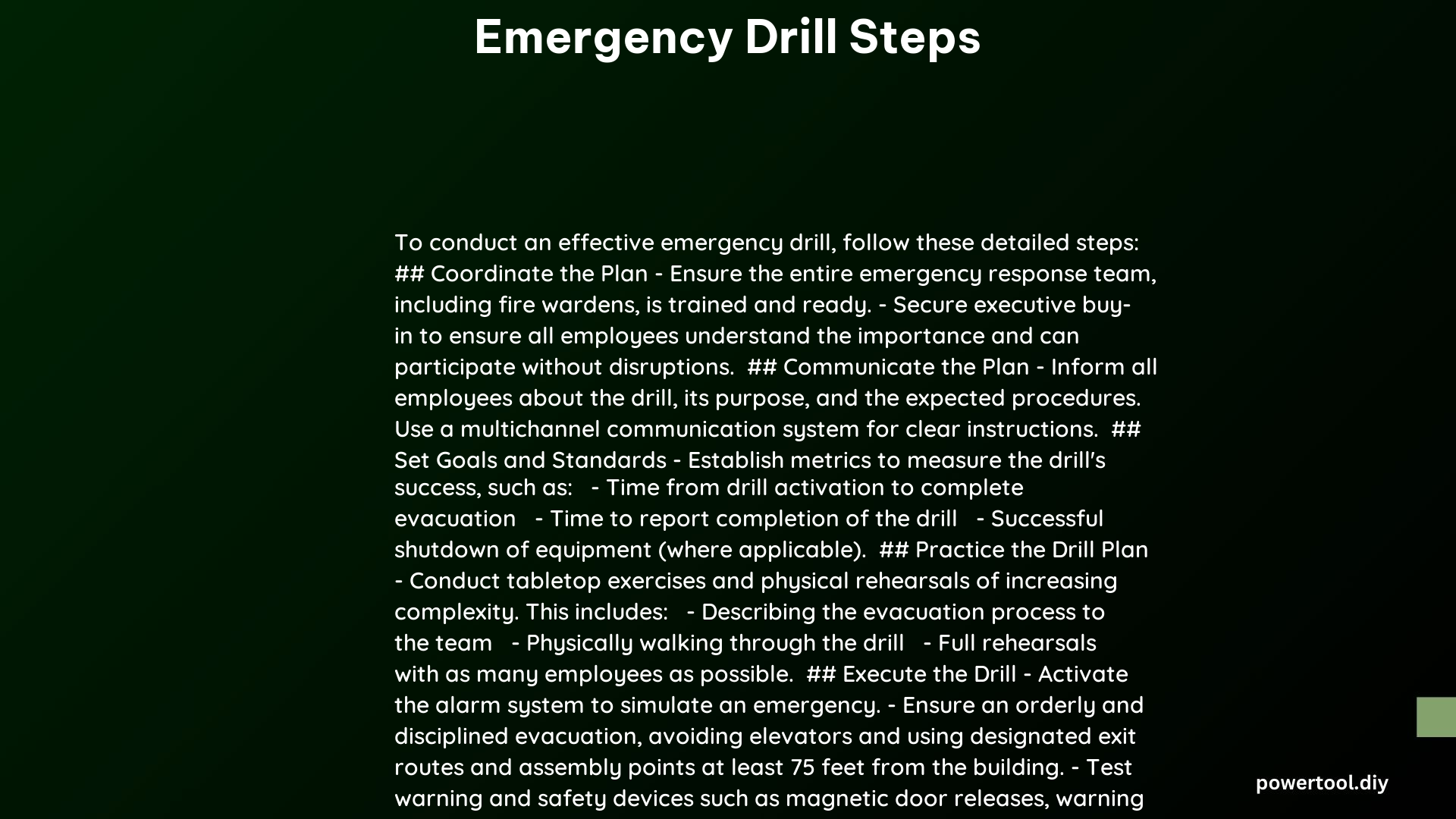Emergency drill steps involve a structured approach to prepare for, execute, and evaluate safety procedures. These steps include establishing clear objectives, creating evacuation plans, coordinating with authorities, educating occupants, training staff, and conducting thorough evaluations. Proper implementation of these steps ensures effective emergency preparedness and response in various settings.
What Are the Key Phases of Emergency Drill Steps?
Emergency drill steps can be divided into three main phases:
- Preparation Phase
- Execution Phase
- Evaluation Phase
Let’s explore each phase in detail.
How to Prepare for an Emergency Drill?

The preparation phase is crucial for a successful emergency drill. Here are the key steps:
- Establish Clear Objectives: Define what you aim to achieve with the drill.
- Create an Evacuation Plan: Develop a detailed plan including routes and assembly points.
- Coordinate with Local Authorities: Notify and involve relevant emergency services.
- Educate Occupants: Inform all participants about procedures and their roles.
- Train Staff and Volunteers: Ensure all personnel are well-prepared for their responsibilities.
- Communicate the Drill: Inform participants about the upcoming drill in advance.
What Steps Are Involved in Executing an Emergency Drill?
The execution phase is where the plan is put into action. Follow these steps:
- Announce the Drill: Start the drill with a clear announcement.
- Sound the Alarm: Activate the emergency alert system.
- Simulate Realistic Scenarios: Create challenges to test preparedness.
- Monitor the Evacuation: Observe and guide the evacuation process.
- Assembly at Designated Points: Ensure all participants gather at predetermined locations.
How to Evaluate the Effectiveness of an Emergency Drill?
The evaluation phase is critical for improvement. Here’s how to conduct it:
- Conduct a Debrief: Gather immediate feedback from participants.
- Analyze Data: Review evacuation times and adherence to procedures.
- Observation Reports: Collect detailed reports from designated observers.
- Feedback Forms and Scoring Criteria: Use surveys and establish evaluation metrics.
- Update Procedures: Make necessary adjustments based on findings.
What Are the Responsibilities of Different Participants in an Emergency Drill?
Different roles have specific responsibilities during an emergency drill:
| Role | Responsibilities |
|---|---|
| Fire Wardens/Safety Officers | Monitor evacuation, guide occupants, complete reports |
| Evacuation Team | Assist in guiding, ensure complete evacuation, report issues |
| Occupants | Follow procedures, gather at assembly points, provide feedback |
| Local Emergency Services | Provide support, feedback, and professional insights |
| Management | Coordinate drill, ensure safety, implement improvements |
What Metrics Should Be Used to Evaluate an Emergency Drill’s Effectiveness?
To assess the success of an emergency drill, consider these metrics:
- Evacuation Time
- Route Efficiency
- Adherence to Procedures
- Feedback Form Results
- Observation Report Findings
What Is the Ideal Timing and What Tools Are Needed for an Emergency Drill?
Timing and tools are crucial elements of an effective emergency drill:
- Total Duration: Typically 15-30 minutes
- Phase Lengths:
- Preparation: Several days to weeks
- Execution: 15-30 minutes
- Evaluation: Several hours to days
- Required Tools:
- Fire extinguishers
- First aid kits
- Alert systems
- Communication devices
- Safety equipment (helmets, gloves)
What Safety Equipment Is Essential for an Emergency Drill?
Ensure the following safety equipment is available:
- Helmets and Gloves
- Ice-Slip Traction Cleats (for icy conditions)
- Communication Devices
How Can Emergency Drill Steps Be Customized for Different Scenarios?
Emergency drill steps can be adapted to various scenarios:
- Fire Drills: Focus on quick evacuation and fire suppression techniques.
- Earthquake Drills: Emphasize “Drop, Cover, and Hold On” procedures.
- Active Shooter Drills: Practice lockdown procedures and communication protocols.
- Chemical Spill Drills: Include proper use of personal protective equipment and containment procedures.
What Common Mistakes Should Be Avoided During Emergency Drill Steps?
Avoid these common pitfalls:
- Lack of clear communication
- Insufficient preparation time
- Failure to involve all stakeholders
- Neglecting to update procedures based on drill results
- Conducting drills too infrequently
How Often Should Emergency Drills Be Conducted?
The frequency of emergency drills depends on various factors:
- Legal requirements (which vary by location and industry)
- Type of facility (e.g., schools, hospitals, offices)
- Risk assessment results
- Changes in building layout or occupancy
Generally, it’s recommended to conduct drills at least twice a year, with more frequent drills for high-risk environments.
What Are the Legal Requirements for Emergency Drills?
Legal requirements for emergency drills vary by jurisdiction and industry. However, common elements include:
- Minimum frequency of drills
- Documentation of drill procedures and results
- Specific requirements for certain industries (e.g., healthcare, education)
- Compliance with local fire codes and safety regulations
Always consult local authorities and industry-specific guidelines for exact requirements.
References:
1. https://www.altusfire.com/fire-safety-resources/how-to-conduct-and-evaluate-effective-fire-drills/
2. https://preparedex.com/essential-emergency-drills-for-the-workplace/
3. https://www.lifesafetyexpress.com/staff-training/fire-drill-execution-evaluation/
